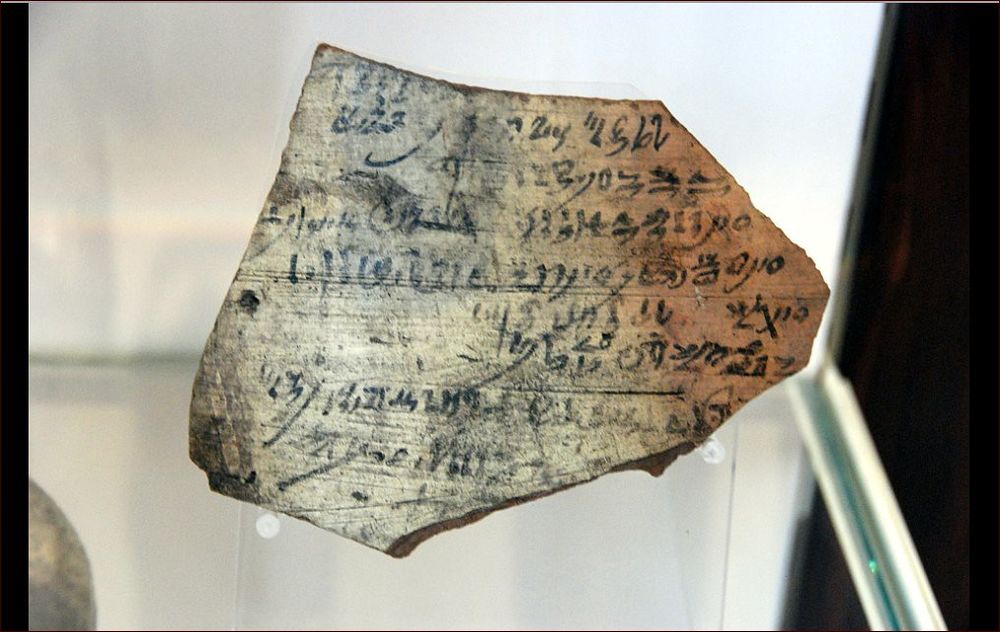In February 2022, archaeologists discovered over 18,000 Egyptian ostraca in Athribis. The news was full of headlines about pottery fragments, and everyone knew what a big deal it was. But the road to such an awareness has been long. It has taken years to discover, analyse and understand the relevance of what ostraca are, and what they signify. Even today, historians and Egyptologists continue to approach the extant evidence to reiterate the cultural narratives they reveal. Here is what we know about them.

Ancient Egyptian Ostraca in the Altes Museum, Berlin. Photo: Hans Ollermann/Flickr
What are ostraca?
An ostracon is a fragment of ceramic material that is used as writing material. Such fragments are most often discovered on archaeological sites, and have been found to be prevalent in ancient Near Eastern art and in Egypt, especially during the Proto-Elamite period between 3200 and 2700 BC. Today, hoards of ostraca sit on display at The Met, studied by dubious researchers for their nonsensical imagery and surprisingly accurate writings.
There were a lot of purposes that an ostracon could solve. Many hold laundry lists, school texts, receipts and calculations. Yet others display distinct narratives that are today interpreted as visual representations that parody the Egyptian social hierarchy. This is not your average art—a seated monkey is seen interacting with a bipedal cat, and animals take on the roles of musicians in these images. In contrast to Near Eastern art, Egyptian ostraca were simpler, crafted mainly from materials locally available in a region called Deir el-Medina. This was an ancient Egyptian artisans’ village that was thronged by working men and women. The common sightings of such ostraca and the low standard of artistry makes them less valuable than other highly revered artworks of the time. In today’s world, these anthropomorphics are studied mainly to understand the country’s social milieu. The work evidently drew on concepts of the elite, but were constructed by the working class. Many works on papyri, an elite material, resemble the imagery on the ceramic ostraca of the land. Could this suggest a correlation between the workers and the commissioners?

Photo: Hans Ollermann/Flickr
The 2022 discovery, made in Athribis near Luxor, depicts various textual representations marked in ink with hollow reeds and sticks. Scorpions and birds, deities and humans and geometrical figures have been found etched on the surfaces. Along with images drawn by children and sentences written by mischievous students as punishment, these hoards depict arithmetic, lists, academic work and other writings from daily life. The text on these pieces of jars and vessels were written in Demotic, Greek, Arabic scripts and Egyptian hieroglyphics. Demotic, which is found on about 80 per cent of the ostraca, was the administrative language of the land during the reign of Ptolemy Xll (81 to 59 Bce and 55 to 51 BCE).

Accounts of food ration distributed to workers of Deir el-Medina. Photo: Hans Ollermann/Flickr

A literary ostracon. Photo: Hans Ollermann/Flickr
While ostraca have been around for a long time, discovery of writings in such large numbers have been rare. The last unearthing of a significant amount of Ostraca was in Deir el-Medina, where excavations revealed a host of medical writings. Using the recent new discovery, archaeologists will be able to decipher economic traditions and the socio-economic culture of the time. We will soon know things such as how trade happened in ancient Egypt, how schools planned their education systems, what wheat cost and a lot more.
References
# The Met
# Smithsonian Magazine
# CNN












Comments
Post a Comment